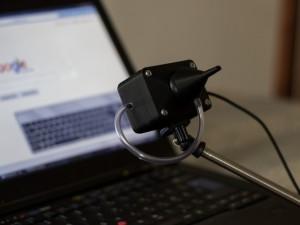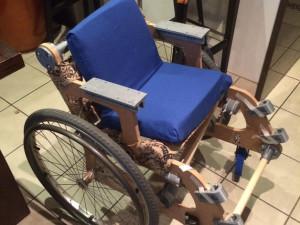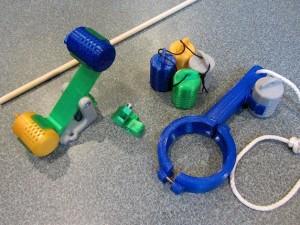 The design and development of assistive technology is one of the most promising facets of the 3D printing revolution. Easing the lives of people with disabilities has been a priority for a number of companies, schools, and organizations who have sponsored challenges and makeathons geared towards the development of assisitve devices. At the end of September, MakerBot launched an Assistive Technology Challenge that invited Thingiverse users to use the recent Bay Area Makeathon as inspiration to develop their own assistive devices.
The design and development of assistive technology is one of the most promising facets of the 3D printing revolution. Easing the lives of people with disabilities has been a priority for a number of companies, schools, and organizations who have sponsored challenges and makeathons geared towards the development of assisitve devices. At the end of September, MakerBot launched an Assistive Technology Challenge that invited Thingiverse users to use the recent Bay Area Makeathon as inspiration to develop their own assistive devices.
Today, MakerBot announced the winners of the competition, which officially closed on November 1. Out of 170 entries, the top design was produced by a user named Tobias Wirtl. His Mouth Operated Mouse allows people without the use of their arms to easily use computers, and it was purposefully constructed using inexpensive, easily obtainable parts to make it accessible to people even with very limited resources.
“There are many new technologies that people with disabilities can’t access and in my opinion everyone should be able to benefit from today’s media, especially the Internet,” said Wirtl. “That’s why I decided to create a device that would allow people to navigate the Web. Products like these sell for hundreds of dollars. I created this one with one 3D printer and about $20 worth of commonly available components.”
The mouse was designed as a mouthpiece with a small joystick attached. To activate what would be the right button on a standard mouse, the user pushes the joystick toward the case. To use the left button, the user draws in air to activate a sensor. The system is controlled by an Arduino Pro Micro. The mouthpiece itself was 3D printed, and all other components, including hardware and electronics, were obtained from local hardware stores and on eBay. The device’s sensor is particularly ingenious; Wirtl disassembled an electronic cigarette for its internal components. He isn’t fully satisfied with design just yet, however, and he invites anyone with an ideas for how to improve the device to contact him or to modify the open source design themselves.
 Second place went to architect Hugo Riveros, who designed a wheelchair that he named “HU-GO.” Riveros, who is originally from Chile, was visiting home when he was struck by how many people who need wheelchairs are unable to afford them. Basing his design off of his own wheelchair, which he has to use periodically due to a condition called spondylo arthritis, Riveros created a 3D printable version that he designed using ArchiCAD software. (We first covered his design last month, when he was just getting started.) For the parts that couldn’t be 3D printed, Riveros, like Wirtl, used inexpensive, readily available components like plywood, zip ties and even socks and flour sacks for cushioning. His hope is that his design will make its way to third world countries were access to expensive medical technology is unavailable.
Second place went to architect Hugo Riveros, who designed a wheelchair that he named “HU-GO.” Riveros, who is originally from Chile, was visiting home when he was struck by how many people who need wheelchairs are unable to afford them. Basing his design off of his own wheelchair, which he has to use periodically due to a condition called spondylo arthritis, Riveros created a 3D printable version that he designed using ArchiCAD software. (We first covered his design last month, when he was just getting started.) For the parts that couldn’t be 3D printed, Riveros, like Wirtl, used inexpensive, readily available components like plywood, zip ties and even socks and flour sacks for cushioning. His hope is that his design will make its way to third world countries were access to expensive medical technology is unavailable.
 In third place is Jeff Kerr, who designed a kit to help dogs help people. The Assistive Devices for Assistance Dogs starter kit includes several 3D printable items to help assistance dogs better navigate environments designed for people, but which their people cannot navigate alone. The items include a paddle that allows dogs to manipulate light switches, a door knob puller and scent coded training fobs to teach dogs how to better distinguish between multiple targets in cluttered environments.
In third place is Jeff Kerr, who designed a kit to help dogs help people. The Assistive Devices for Assistance Dogs starter kit includes several 3D printable items to help assistance dogs better navigate environments designed for people, but which their people cannot navigate alone. The items include a paddle that allows dogs to manipulate light switches, a door knob puller and scent coded training fobs to teach dogs how to better distinguish between multiple targets in cluttered environments.
“Each time we hold a MakerBot Thingiverse Challenge, we are amazed by the things people create,” said Nadav Goshen, President at MakerBot. “We’d like to thank everyone who participated in this challenge and we encourage people to continue to create and expand upon these designs to empower even more people around the world who have disabilities.”
Subscribe to Our Email Newsletter
Stay up-to-date on all the latest news from the 3D printing industry and receive information and offers from third party vendors.
Print Services
Upload your 3D Models and get them printed quickly and efficiently.
You May Also Like
Metal Powder Supplier Elementum 3D Added to $46B Air Force Contract
Elementum 3D, a Colorado-based developer and supplier of metal powders used in additive manufacturing (AM), announced that the company has been added to the vendors list in the fourth on-ramp...
Ursa Major Lands $28.6M AFRL Deal for 3D Printed Draper Engine Flight Demo
The US Air Force Research Laboratory’s (AFRL’s) Rocket Propulsion Division at Edwards Air Force Base has awarded a $28.6 million contract to Ursa Major for follow-on work related to the...
3D Printing Financials: Rocket Lab’s Record-Breaking Year and Over 20 Launches Coming in 2025
Rocket Lab (Nasdaq: RKLB) closed 2024 with its best year yet. The company launched more rockets, signed more contracts, and expanded deeper into spacecraft and satellite production than ever before....
US Air Force Taps Beehive to Study 3D Printed Jet Engines
Propulsion 3D printing firm Beehive Industries secured a contract from the U.S. Air Force Life Cycle Management Center through SOSSEC. SOSSEC is a company that manages Other Transactions Authority (OTA)...

































